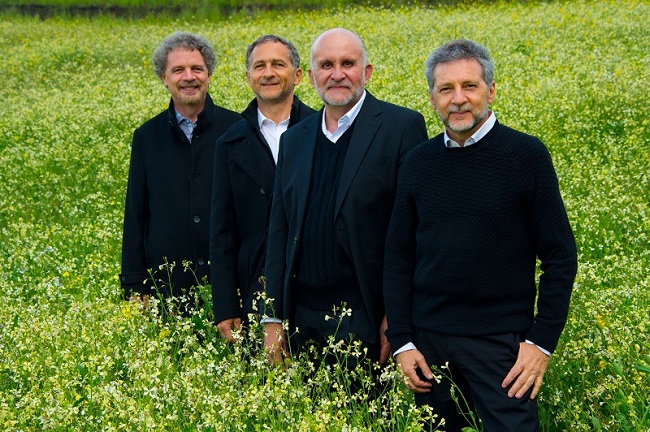Cuarteto Latinoamericano celebrates forty years together with fiesta of Mexican music

Cuarteto Latinoamericano performed Saturday night at the Horowitz Visual and Performing Arts Center in Columbia, Md. Photo: Sergio Yazbek
The Cuarteto Latinoamericano formed in Mexico in 1982. Three brothers—violinists Saúl Bitrán and Arón Bitrán plus cellist Álvaro Bitrán—joined with violist Javier Montiel to champion the string quartet repertory of Latin American composers. Nearing their 40th anniversary, this respected ensemble performed a tribute to the music and art of their native Mexico Saturday night, presented by Candlelight Concert Society at Howard Community College.
Benjamín Juárez, professor of fine arts at Boston University, led a 90-minute exploration of the connections between music and art in Mexican history from the Aztecs to the modern day. Six music examples punctuated this slideshow presentation, pieces from the 18th century to the end of the 20th century performed by Cuarteto Latinoamericano.
Little has survived of Aztec music beyond a few descriptions and illustrations, but Juárez traced how this indigenous tradition merged with music brought from Spain. These beginnings were represented by the music of Ignacio Jerusalén y Stella (1707-1769), a composer and violinist born in Italy. He later resided in Cádiz, where he was convinced to move to Mexico City and take up musical positions at the Coliseo de México and then the city’s cathedral.
Jerusalén’s sacred compositions circulated widely in New Spain, as did his works for orchestra and violin. The quartet played an arrangement of a fast movement from one of his overtures. The group has recorded the majority of works composed by Latin American composers for string quartet, but nothing by this composer. With some lack of ensemble unity and intonation problems in the lower strings, it was a rocky start.
Juárez compared the music of Gustavo Campa (1863-1934), a composer born in Mexico City who eventually became the influential director of the Conservatorio Nacional, to the internationally recognized landscape paintings of José María Velasco. Cuarteto Latinoamericano sounded more at ease in his Trois Miniatures, which they recorded a decade ago. The Menuet and Gavotte danced with restrained elegance. The final movement, a theme and variations, stood out for its muted last variation, a beatific apotheosis of soft sound.
The quartet has also recorded much of the music of Manuel Ponce (1882-1948), who combined his studies of European music with an interest in Mexican popular music. His Estrellita, a sentimental love ballad, featured a popular song-style melody in learned counterpoint between the two violinists. His Gavota put most of the melodic weight on the violinists as well, who spun out a refined tandem sound. Double-stops and exposed passages continued to reveal some of the weaknesses of this veteran ensemble.
The best performances came in the last three pieces, more daring and modern in the wake of the Mexican Revolution. Carlos Chávez was even more influenced by indigenous music, mixing those elements with European styles in a way Juárez compared to the murals of Diego Rivera. The dynamic first movement of his String Quartet No. 3 rocketed energetically from urbane sounds to more chaotic ones in the development section.
In a similar way, Silvestre Revueltas’s Música de Feria was a wild rumpus of sound, an Ivesian depiction of the tumult of musical sound at a fairground. Javier Montiel’s viola brayed boldly out of the texture, answered by the two violinists in melodious pairing. In the slow middle section, first violinist Saúl Bitrán glowed on the otherworldly flautando solo, followed by a tender love song for the whole group with mutes on.
Juárez drew a parallel between the music of Gabriela Ortiz (b. 1968) and conceptual artist Gabriel Orozco, who both came of age in the wake of the student protest movement of 1968. The quartet performed “La Calaca,” the final movement of her Altar de Muertos, a work about the Mexican concept of death, seen from both European and indigenous perspectives. Ortiz’s parents were both folk musicians, a sound world she mixes with modernist influences from her studies in Europe.
At the end of this movement, Ortiz quotes a Huichol melody, a musical gesture that brought the evening full circle back to the opening discussion of indigenous musical traditions in Mexico. As in the group’s recording of the piece from 2005, this performance pulsed with pleasing rhythmic drive and complex polytonal clusters. A pizzicato section felt akin to the sound of a folk guitarist, balanced by a fugal passage in driving sixteenth notes. The closing section, on that multimetric Huichol melody, galloped to a dramatic finish.


